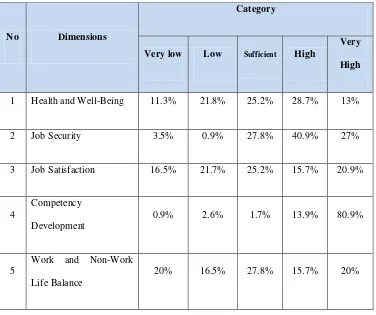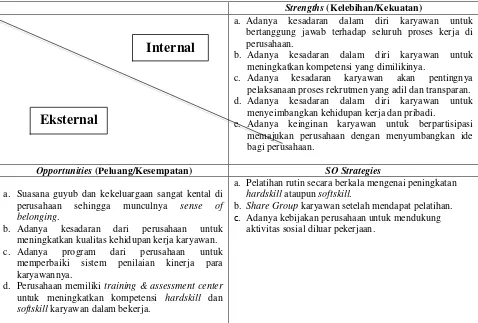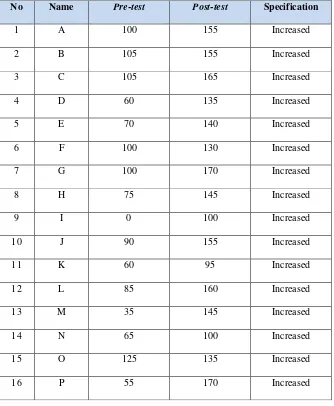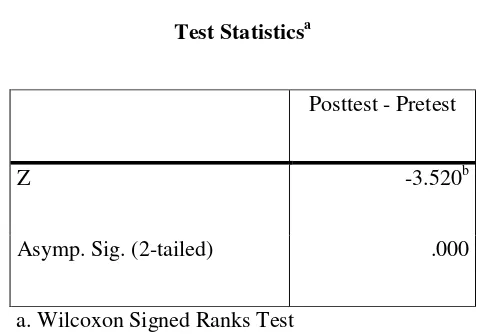Quality of Work Life Program
to Enhance and Align the Industrial Relations
Verina H. Secapramana Cynthia Meissa Nur Humaira
University of Surabaya Faculty of Psychology
Advances in technology and globalization bring various effects on the employment issue in Indonesia, including the effect of freedom to make association. These conditions lead to polarization between the interests of management and the interests of workers, which is commonly discussed as industrial relations. If the problems in industrial relations can not be solved, then a strike action will happen, which causes damage to many parties.
The following research is part of a series of research that aims to develop and implement programs based on the concept of Quality of Work Life (QWL). The assumption used is when the quality of working life increases, it is expected that the quality of industrial relations will also increase, which in turn will increase productivity, organizational performance and competitiveness. From 5 dimensions of QWL, the focus of this research is on the dimension of work and non-work life balance, with the special topic of time management and assertive communication.
Keywords : Quality of Work Life ( QWL ) , industrial relations, work and non-work life balance dimension, time management, assertive communication
PRELIMINARY
The era of globalization brings freedom from the influence of the developed countries to Indonesia as developing country, including freedom of to make association which is seen as a fundamental human right. Two different parties with different interests raises two polarization interests of employers and workers' interests. Openness and the interests of certain parties led the rallies and strikes of workers. Data sourced from DG PHI and JSK, which is processed by Pusdatinaker, showed that the number of strikes / demonstrations conducted in 2010 was 82 cases involving 1,982 workers as well as the number of lost work is 10 571 working hours. Data in the year 2011 issued by the same source showed an increase, namely in Indonesia occurred 303 cases, involving 64 820 workers and resulting in loss of 1,891,387 working hours. On one side the strike is a reflection of the air of democratic widespread, but on the other hand it is also clear that such action also caused a lot of losses, both in terms of working hours lost, the cost of which evaporates, productivity decreases, disruption of stability public safety, as well as the erosion of employee morale, which in the long run will lead to the loss of the nation, both economically (increased country risk, investment decline, the weakening economy), socially, and morally. It is undeniable that the proliferation of protests can be seen as an expression of the increasingly demands of life, insufficient high cost of living, and unfulfilled some of the needs of employees, as well as an evidence of the persistence of the gap which is relatively high among the leaders companies with workers. In other words, the harmony of industrial relations has not been reached between the various parties concerned. Data in 2011 recorded the entry of 4,242 cases of industrial disputes, with 2,429 cases can be decided (source Directorate of PHI and JSK, processed by Pusdatinaker).
national problem, it is necessary that various parties have to participate in thinking about it and looking for an alternative address such problems, mainly a more preventive one. Handling of industrial relations is to be a shared responsibility between the government, employers, employees, and universities / academics.
Speaking about the role of universities / academics, one of the advantages that can be used as a contribution for the benefit of society, the state and the nation, is the mastery of the theoretical concept along with the possibility of its implementation. The concept offered in the following research is the application of the theory of Quality of Work Life (hereinafter referred to as QWL).
QWL is a sense of satisfaction that is owned by the employee to work, colleagues, and his organization, which will lead to growth and profit organizations (Heskett, Sasser, & Schlesinger, 1997). A pleasant working environment and conducive to support and enhance job satisfaction, with the availability of awards, safety at work and a good opportunity to develop (Lau et al, 2001). QWL program aims to provide education, both for the workers and for the leadership of the company, to create a harmonious working relationship and harmony of the entire organization. The program is expected to be able to align the interests of all members of the organization, particularly between the interests of management with the interests of employees, which in reality often have gaps. The creation of a harmonious relationship between management and employees are expected to be able to facilitate communication in order to address the gaps, which in essence will improve and increase the balance in industrial relations. While the working conditions are getting better and more qualified, then the impact will be seen in increased productivity and employee and organizational performance. With the implementation of this program, it is not just the management who will be helped, but the employees will be benefited.
entrepreneurship. (Ahmad Djauhar, Entrepreneur Party and TBTF phenomenon, Bisnis Indonesia, September 4, 2015). QWL program has the intention to educate members of the organization to have the entrepreneurial spirit within himself.
Research of Ann Claire Otto and Bourguet (2006) reported the experience of a college in developing QWL initiatives, including surveys conducted in other medical school is used as a benchmark. The case studies conducted on the three institutions in the United States, which is a private university with QWL program already established, a state university with QWL program in transition, and one medical school in the developing stage. Stanford University School of Medicine have QWL program established in 1996 and is considered successful as making a good impact for the organizational development. They have two head office of the university, Worklife and Faculty and Staff HELP Center, and the School of Medicine's Prevention Research Center's Health Improvement Program, which offers Quality of Work Life program. The function of the HELP center provide professional and confidential counseling to staff members and faculty, as well as spouses and children under the age of 21 years. The counseling center also offers a variety of workshops with various topics surrounding the problems encountered daily, such as stress management, anger management, nutrition, humor, and so on. Office of worklife institutions providing child care and elderly people, giving a description of the work-life balance. There is also a program providing scholarships for members of the organization, daycare, home offices for a while during the lecturers have not been getting home, as well as low-interest loans for the purchase of a house located at one location. The support of the faculty and staff through a variety of resources related to the benefits, programs, policies, and activities is the key to the success of Stanford University's School of Medicine.
Office) was established as part of the HR division, and a work plan for three to five years to be developed. The program focused on communication, leadership, and work-life effectiveness. Training programs and counseling provided, including support for the family, the balance between work and family, or preparation for retirement. A session on "Creating a Healthy Workplace" was given to the new leadership as well as mid-level managers. Various health programs are provided for employees, including a program for children of employees.
The Northeastern Ohio Universities College of Medicine, a public college that stands alone with QWL program is growing. Preceded by a preliminary survey, job satisfaction of the conditions and needs of the welfare program, as well as training and development needs, the results from this survey was followed by sorting and feasibility study program. To implement all these four groups of task force are formed, including campus life, professional and career development, benefits (for example the establishment of employee assistance programs or counseling center for employees and all of their families) as well as prizes and awards.
Among the three universities studied, it is concluded that the organizational support of the family is beneficial to improving the welfare and performance of employees. It is recommended that medical school could be an example for other organizations, as well as develop and publish a strategy for QWL models.
Research from Joseph M. Sirgy, Nora P. Relly, Jiyun Wu and David Efraty (2008) describe the QWL program undertaken to improve the Quality of Life in a way 1) provide resources that work in accordance with the expectations of the role of the employee's identity; 2) reducing the labor conflict in working life and personal (non-work); 3) enhance the role of dual identity; 4) reducing the demands of the role; 5) reduce the stress associated with the role of identity in the world of work and non-work; and 6) enhance the value of role identity. Some programs QWL formed to improve the well-being related to working life, such as the organizational structure of decentralization, teamwork, structure parallel, mission and organizational culture of ethical, work schedules, and so on, as well as programs related to personal life outside of work, such as doing a task at home, flexible hours, part-time work, job sharing, and so on.
satisfaction, competency development, and work and non-work life balance. The fifth aspect of the improvement of Quality of Work Life can be implemented as an ongoing program, adapted to the conditions of the organization, employee conditions and development stages in the period of change.
The following research is actually a part of a series of several studies. The first step begins with a survey of QWL in organization X, in order to determine the condition of the base (base line) organization. This data is then used as a reference to determine further action.
RESEARCH METHODS
This study used action research design. Arnold, Cooper and Robertson (2004, referring to Lewin, 1946) used the term to describe the action research study in which researchers and research subjects participating together. Action research is intended in addition to solving the problems facing the subject of research, as well as to increase knowledge about the topic being studied. This research not only diagnose and investigate a specific problem, but it also makes changes in the organization of work, based on research results, and evaluate the impact of these changes. Action research can use a variety of other research methods, but as a qualitative research, in general, the most widely used method are interview and participant observation. Furthermore, compared with other study design, this method is driven by specific problems that arise in the organization and the desire to solve them. Susman (1983) describes five steps in conducting action research, namely: identify the problem, to consider various alternatives related solutions to these problems, carry out actions solution, an evaluation related to the action solution that has been done, and the last step is to study about the success of the solution (in O'Brien, 1983.
RESULTS AND DISCUSSION
1. Survey of QWL in Organization.
another dimension of QWL as an overall concept. It is also based on the concept of thinking which is owned by the management of the company that the welfare of employees in private life is directly proportional to the productivity of labor has, in addition to other considerations that the dimensions of job satisfaction is usually a sensitive issue because it is related to remuneration, so it would be wiser not to discuss in the initial study. The next step is to focus on the dimensions of a balance between work and personal life. The method used was interview and focus group discussion (FGD), and then based on these data the SWOT analysis was made.
Table 1 Dimensions of Quality of Work Life
No Dimensions
Category
Very low Low Sufficient High
Very High
1 Health and Well-Being 11.3% 21.8% 25.2% 28.7% 13%
2 Job Security 3.5% 0.9% 27.8% 40.9% 27%
3 Job Satisfaction 16.5% 21.7% 25.2% 15.7% 20.9%
4
Competency Development
0.9% 2.6% 1.7% 13.9% 80.9%
5
Work and Non-Work Life Balance
Table 2. Work and Non-Work Life Balance Dimension
2. SWOT Analysis of the Interview and FGD result (e.g, strength and opportunities) Aims to see the map of the problems faced by employees of the organization, particularly with regard to the dimensions of work and non-work life balance.
Strengths (Kelebihan/Kekuatan)
a. Adanya kesadaran dalam diri karyawan untuk bertanggung jawab terhadap seluruh proses kerja di perusahaan.
b. Adanya kesadaran dalam diri karyawan untuk meningkatkan kompetensi yang dimilikinya.
c. Adanya kesadaran karyawan akan pentingnya pelaksanaan proses rekrutmen yang adil dan transparan. d. Adanya kesadaran dalam diri karyawan untuk
menyeimbangkan kehidupan kerja dan pribadi.
e. Adanya keinginan karyawan untuk berpartisipasi memajukan perusahaan dengan menyumbangkan ide bagi perusahaan.
Opportunities (Peluang/Kesempatan) SO Strategies
a. Suasana guyub dan kekeluargaan sangat kental di perusahaan sehingga munculnya sense of belonging.
b. Adanya kesadaran dari perusahaan untuk meningkatkan kualitas kehidupan kerja karyawan. c. Adanya program dari perusahaan untuk
memperbaiki sistem penilaian kinerja para karyawannya.
d. Perusahaan memiliki training & assessment center
untuk meningkatkan kompetensi hardskill dan
softskill karyawan dalam bekerja.
a. Pelatihan rutin secara berkala mengenai peningkatan
hardskill ataupun softskill.
b. Share Group karyawan setelah mendapat pelatihan.
c. Adanya kebijakan perusahaan untuk mendukung
aktivitas sosial diluar pekerjaan.
The same analysis conducted for the category strength and threats, weaknesses and opportunities, as well as the weaknesses and threats. Most of the results of SWOT analysis, particularly with regard to the dimensions of work and non-work life balance, giving a description of the employee as follows:
a. The existence of a conflict of interest so that one's life should be sacrificed. It is caused by some employees lack of the communication skills to explain the situation in the company to his family.
b. Most employees lack the ability in terms of time management so that it affects their performance results.
c. Sometimes the results of the training followed by the employee is not applied in practice. d. The presence of employees who are resistant to change, making it difficult to adjust to the system and a new company policy.
e. The difficulties on the employee in the processing of emotions when having problems at work or in private so that the majority of emotions issued is negative emotions.
Based on the above results, then further action as an intervention was planned, such as training to improve time management skills and assertive communication.
3.Time Management Skills Training and Assertive Communication
This training is intended to improve understanding of the importance of managing and utilizing the time available on a priority basis, and to increase understanding of the importance of assertive communication in family communication and to train these skills, so as to support employees to be professional and assist them in balancing work and personal life. The training was conducted for 1 (one) day from the two (2) days planned time, is associated with a flurry of employees in the workplace, making it impossible for them to leave the task for too long. Rundown was created and training was conducted by three trainers. Follow-up carried out a week after training. The follow-up conducted by the researchers is in the form of person to person interview.
points range between 0, 5 and 10; so that the lowest value is 0 and the highest is 170. Based on Table 4, it can be seen that overall participants experienced positive changes between before and after the training. It is seen from the increase results from the pre-test and post-test they have done. The data were statistically analyzed using SPSS (Statistical Package for the Social Sciences) by different non-parametric test (Wilcoxon test).
Table 4. Analysis of Results of Evaluation of Learning
Based on these results, it can be concluded that there is a difference between the pre-test and post-test on the implementation of the training because sig. (0000) is less than 0.05 Overall it can be concluded that all participants are able to understand the importance of having time
No Name Pre-test Post-test Specification
1 A 100 155 Increased
2 B 105 155 Increased
3 C 105 165 Increased
4 D 60 135 Increased
5 E 70 140 Increased
6 F 100 130 Increased
7 G 100 170 Increased
8 H 75 145 Increased
9 I 0 100 Increased
10 J 90 155 Increased
11 K 60 95 Increased
12 L 85 160 Increased
13 M 35 145 Increased
14 N 65 100 Increased
15 O 125 135 Increased
management in balancing work and personal life. They emphasized that effective time management in the work environment has a positive influence on his personal life. Therefore, with the presence of effective time management, they can do their task in accordance with priorities so that they are able to complete the task in a timely and quality work produced results. One of the participants (called L) has been trying to sort out its work based on the nature and timing of collection. However, he can not consistently complete the tasks based on his list because against someone who has a higher position sometimes gave the order to complete another assignment.
Table 5. Wilcoxon test
Test Statisticsa
Posttest - Pretest
Z -3.520b
Asymp. Sig. (2-tailed) .000
a. Wilcoxon Signed Ranks Test
b. Based on negative ranks.
All participants are able to understand the importance of the implementation of assertive communication within the family. With the assertive communication, then each member of the family has the opportunity to express their opinions and desires owned so as to create a democratic atmosphere in the family. In addition, assertive communication also helped some trainees in giving freedom to his family members to provide opinions and also explain its busy work so that it avoids any negative thoughts from family members and can minimize misunderstandings.
communication also plays a role when the boss gives feedback to subordinates so as to facilitate the process of self-development of employees.
CONCLUSIONS AND RECOMMENDATIONS
1. The intervention applied in this research is to understand and practice time management skills and assertive communication as a means to balance work and personal life. In the quantitative analysis, there is a change which is owned by the participants associated with cognitive or knowledge about time management and assertive communication. It is intended that they have understood the importance and the implementation of effective time management as the media to shape their professional attitude in the work environment, so that it can be used as a means of balancing work and personal life. In addition, they also understand the importance of the implementation of assertive communication to establish effective communication links between family members. Therefore, the purpose of training associated with cognitive or knowledge has been reached.
2. In terms of quantitative and qualitative analysis, there is a cognitive changes experienced by the research subjects after getting intervention in the form of training on the formation of professionalism through time management and assertive communication as a means of balancing work and personal life.
3.The subject of the study is able to understand the importance of being professional with meaningful work, time management, and assertive communication; so that it can assist them in balancing work and personal life.
From the above results, it can be given the following recommendations: 1. For Employees
2.For Organizations
Management has also an important role in shaping the professionalism culture of the organization in order to assist employees in balancing work and personal life. Things that can be done by management, among other things are : improving the performance appraisal system, creating a workload analysis to determine how much the workload of each employee so that it will give the impact on the time management pattern they have.
3.List of question on the follow-up process is less related to the ability to dig up information that has been applied to the trainees in terms of time management and assertive communication. Questions put by researchers tend to dig up information in terms of the level of understanding of the trainees about the importance of having a professional attitude with emphasis on time management and assertive communication. However, there are some participants who provide information relating to the application of time management in the work environment and an assertive communication in the family and work environment after the training is completed. Therefore, the purpose of the training that participants will be able to apply time management and assertive communication has not been fully achieved.
4. Considering that new study focused only on one dimension of QWL, i.e the dimensions of work and non-work life balance, especially on one topic, namely time management and assertive communication, then further research could examine four other dimensions of QWL and topics more of each dimension. When seeing the results of SWOT analysis, there are many topics that can be studied and designed interventions. Thus there will be the implementation of QWL program more complete and integrated, because it covers all dimensions, accompanied topics that have been adapted to the needs and conditions of the organization.
REFERENCES
Cascio, Wayne F. (2013). Managing Human Resources : Productivity, Quality of Work Life, Profits. 9th ed. New York : McGraw-Hill, Irwin
Cynthia Meisa Nur Humaira. (2015). Membangun Profesionalisme sebagai Budaya Organisasi melalui Pelatihan Manajemen Waktu dan Komunikasi Asertif sebagai Sarana untuk Menyeimbangkan Kehidupan Kerja dan Pribadi. Tesis. Fakultas Psikologi Universitas Surabaya
Considine, G.& Ron Callus.The Quality of Work Life of Australian Employees – The development of an Index. Working Paper 73. University of Sydney.
Cooper, Cary L. & Ivan T. Robertson.(2004). Work Psychology : Understanding Human Behaviour in TheWorkplace . 4th ed. Prentice Hall
Dallimore, E. & Amy Mickel. (2006). Quality of Life : Obstacles, Advice, and Employer Assistance. Human Relations. Jan 2006; 59,1; ABI/INFORM Global pg 61
Decenzo, David A & Stephen P. Robbins. (2002). Human Resource Management. 7th Ed. New York : John Wiley & Sons, Inc.
Delamotte, Y & Walker K. (1974). Humanisation of Work and The Quality of Working Life. Trends and Issues. Bulletin of the International Institute of Labour Study. 11, 3-13
Delamotte, Y & Takezawa, S. (1984). Quality of Working Life in International Perspectives. Geneva : International Labor Office
Dessler, Gary. (2005). Human Resource Management. 10th Ed. New Jersey : Pearson Education, Inc.
Deutsch, S & Schurman, S. (1993).Labour Initiatives for Worker Participation and Quality of Working Life. Economic and Industrial Democracy. 14 : 345-354
George, Jennifer M & Gareth R. Jones. (2002). Organizational Behavior. 3rd. Ed. New Jersey : Pearson Education, Inc.
James, G. (1992). Quality of Working Life and Total Quality Management. International Journal ofManpower.13, 41-59
Lawler, F. (1982). Strategies for Improving the Quality of Work Life. American Psychologist. 37 : 486-493
Maccoby. Helping Labor and Management Set Up a Quality-of-Worklife Program. Monthly Labor Review. March 1984.
Mondy, R. Wayne, Robert M. Noe & Shane R. Premeaux. (2002). Human Resource Management. 8th. Ed. New Jersey : Pearson Education Inc.
Otto, Ann & Claire Bourguet.( 2007). Quality of Work Life Programs in U.S. Medical Schools : Review and Case Studies. Journal of Health and Social Behavior. Spring/Summer 2006, page 17-26
Schuler, Randall S. & Susan E. Jackson. (2006). Human Resource Management- International
Perspectives. USA : Thomson South-Western.
Sirgy, M. Joseph, Nora P. Reilly, Jiyun Wu, David Efraty. A Work-Life Identity Model of Well-Being : Toward a Research Agenda Linking Quality-of-Work-Life (QWL) Programs with Quality of Life (QOL). Published Online : 28 November 2008. Springer Science +
Business Media B.V/The International Society for Quality-of-Life Studies
Vicente Royuela, Jordi Lo’pez-Tamayo, Jordi Surinach. (2007). The Institutional vs the Academic definition of Quality of Working Life. What is the Focus of the European Commission. Published Online. 18 August 2007 at Springer Science + Business Media. B.V 2007



